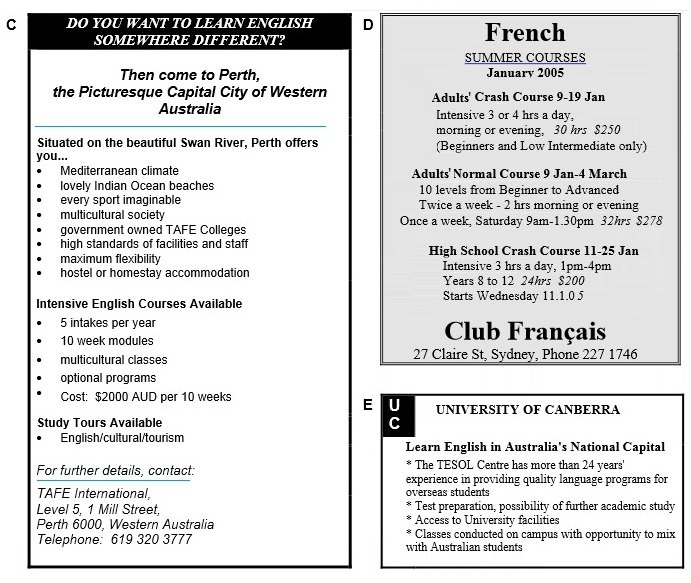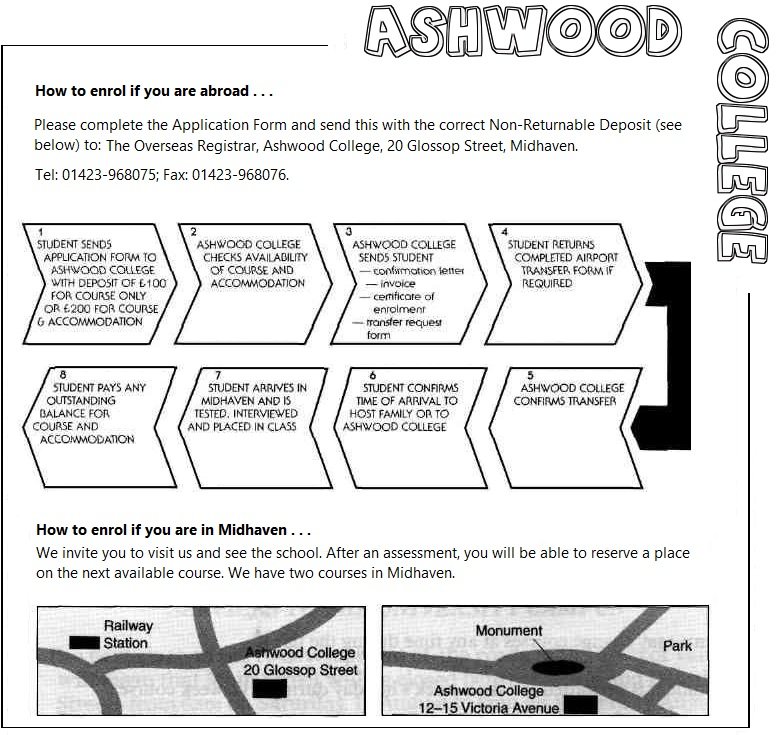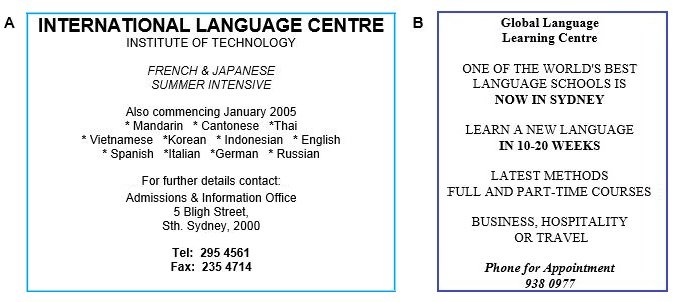Reading Passage 1 – International Language Centre
You should spend about 20 minutes on Questions 1-13 which are based on the text below.

Read the notice about road works below and answer questions 9-13.
MAIN STREET, GATTON RE-DEVELOPMENTROAD WIDENING TO AFFECT WEEKEND TRAFFIC AND BUS The next stage in the re-development of the roads in the town of Gatton will mean that Main Street will be closed between Little and Denning Streets from 6.00 am on Saturday, 12 August to 6.00 pm on Sunday, 13 August. The intersections of these streets with Main Street will not be affected. We expect that the work will be completed at this time without further disruption to traffic. Motorists should note that Main Street will be closed over the weekend during the hours indicated. No university bus services will operate through the area between Little and Denning Streets. However, alternative services will operate on bus routes 566 and 45 between Gatton Road, the town centre and the university. The Transport and Roads Department apologises for any inconvenience caused while improvements are in progress. |
Reading Passage 2 – Ashwood College
You should spend about 20 minutes on Questions 14-26 which are based on the text below.

Deposit/payment:
1. Your enrolment form must be accompanied by the course deposit of £100 or, if you are booking accommodation through the school, your course and accommodation deposit of £200
2. Any balance of course and accommodation fees must be paid in full by the first day of your course.
3. All bank charges incurred in sending money to Ashwood College must be paid by the student.
4. Deposits and payments are non-refundable and non-transferable.
5. A charge of £20 will be made for any changes made to the bookings.
Conditions:
Timetable:
Each hour consists of 50 minutes’ tuition and a 10-minute break.
Public and School Holidays:
There is no reduction in the fee where a course includes a Public Holiday, except for two weeks at Christmas.
Age:
The above centres of Ashwood College do not accept students under 16 years of age.
Attendance:
Students are expected to attend regularly and on time. Students forfeit tuition if they arrive late, are absent or leave before the course ends.
Student Holidays:
Students on long courses, except examination preparation courses, may take a holiday of one week every 12 weeks without losing their course fee for this period.
Location and Time of Course:
Ashwood College has two all-year centres and a summer centre in Midhaven. Before entry to the school, students must take an entry test to determine the level of class they enter. We cannot guarantee the time or location of a student’s course although every attempt is made to place students in the centre and at the time of their choice.
Read the text and answer Questions 21-26
THE TOTARA LANGUAGE INSTITUTE NEW ZEALAND
Study English in a national university with students from many countries.
• 4-week blocks
• 5 hours’ tuition each day
• Examination preparation
• University entry (with appropriate academic and English requirements)
Choice of accommodation for all students – homestays with local families or in Halls of Residence with New Zealand students.
The Totara Language Institute is part of the University of Waikato in the city of Hamilton, in New Zealand’s North Island. Intensive English classes are taught in four-week blocks throughout the year and students may enrol for as many blocks as they wish. Classes are for 5 hours each day, Monday to Friday, and include preparation for several international English language examinations. All the courses are taught by highly qualified teachers, many of whom also teach on Language Institute graduate programmes in second language teaching and applied linguistics. Classes are small, usually from 10-12 students with a maximum number of 15, and normally contain a mix of students from a wide range of countries. Students who study English at the Language Institute become international members of the Waikato Students’ Union. The option is available to move on to university study if students meet the English language and academic entry levels for their choice of programme. The Language Institute provides student support, welfare and activities services. Students are met at Auckland airport on arrival and accommodation is provided with local families or in University Halls of Residence with New Zealand students.
Hamilton, one of New Zealand’s fastest growing cities, is ideally located for a wide range of leisure and cultural activities. The Waikato river, the longest river in New Zealand, flows through the centre of the city, providing a picturesque and park-like setting of riverside walks and gardens. The Waikato region is a diverse agricultural area, rich in historic sites, arts and crafts, hot springs, native forests, mountains and rivers. Within easy reach is an unspoilt coastline; the wild and rugged west coast beaches famous for surfing, and the more peaceful east coast resorts are only a short drive from Hamilton. Further afield the mountains of the central North Island, 3 hours’ drive away, provide superb ski facilities in winter and hiking country in summer.
The Language Institute activities coordinator can assist students to arrange any sport and leisure activities. Assistance is also available for ongoing travel arrangements for students. Students on a visitor visa or work permit may study for a maximum of 3 months. Courses of longer duration require a student permit which is issued for the length of study only.
Reading Passage 3 – The coal industry
You are advised to spend 20 minutes on Questions 27-40.
A Coal is expected to continue to account for almost 27 per cent of the world’s energy needs. However, with growing international awareness of pressures on the environment and the need to achieve sustainable development of energy resources, the way in which the resource is extracted, transported and used is critical.
A wide range of pollution control devices and practices is in place at most modern mines and significant resources are spent on rehabilitating mined land. In addition, major research and development programmes are being devoted to lifting efficiencies and reducing emissions of greenhouse gases during coal consumption. Such measures are helping coal to maintain its status as a major supplier of the world’s energy needs.
B The coal industry has been targeted by its critics as a significant contributor to the greenhouse effect. However, the greenhouse effect is a natural phenomenon involving the increase in global surface temperature due to the presence of greenhouse gases – water vapour, carbon dioxide, tropospheric ozone, methane and nitrous oxide – in the atmosphere. Without the greenhouse effect, the earth’s average surface temperature would be 33-35 degrees C lower, or -15 degrees C. Life on earth, as we know it today, would not be possible.
There is concern that this natural phenomenon is being altered by a greater build-up of gases from human activity, perhaps giving rise to additional warming and changes in the earth’s climate. This additional build-up and its forecast outcome has been called the enhanced greenhouse effect. Considerable uncertainty exists, however, about the enhanced greenhouse effect, particularly in relation to the extent and timing of any future increases in global temperature.
Greenhouse gases arise from a wide range of sources and their increasing concentration is largely related to the compound effects of increased population, improved living standards and changes in lifestyle. From a current base of 5 billion, the United Nations predicts that the global population may stabilise in the twenty-first century between 8 and 14 billion, with more than 90 per cent of the projected increase taking place in the world’s developing nations. The associated activities to support that growth, particularly to produce the required energy and food, will cause further increases in greenhouse gas emissions. The challenge, therefore, is to attain a sustainable balance between population, economic growth and the environment.
The major greenhouse gas emissions from human activities are carbon dioxide (CO2), methane and nitrous oxide. Chlorofluorocarbons (CFCs) are the only major contributor to the greenhouse effect that does not occur naturally, coming from such sources as refrigeration, plastics and manufacture. Coal’s total contribution to greenhouse gas emissions is thought to be about 18 per cent, with about half of this coming from electricity generation.
C The world-wide coal industry allocates extensive resources to researching and developing new technologies and ways of capturing greenhouse gases. Efficiencies are likely to be improved dramatically, and hence CO2 emissions reduced, through combustion and gasification techniques which are now at pilot and demonstration stages.
Clean coal is another avenue for improving fuel conversion efficiency. Investigations are under way into super clean coal (3-5 per cent ash) and ultraclean coal (less than 1 per cent ash). Superclean coal has the potential to enhance the combustion efficiency of conventional pulverised fuel power plants. Ultraclean coal will enable coal to be used in advanced power systems such as coal-fired gas turbines which, when operated in combined cycle, have the potential to achieve much greater efficiencies.
D Defendants of mining point out that, environmentally, coal mining has two important factors in its favour. It makes only temporary use of the land and produces no toxic chemical wastes. By carefully pre-planning projects, implementing pollution control measures, monitoring the effects of mining and rehabilitating mined areas, the coal industry minimises the impact on the neighbouring community, the immediate environment and long-term land capability.
Dust levels are controlled by spraying roads and stockpiles, and water pollution is controlled by carefully separating clean water runoff from runoff which contains sediments or salt from mine workings. The latter is treated and re-used for dust suppression. Noise is controlled by modifying equipment and by using insulation and sound enclosures around machinery.
Since mining activities represent only a temporary use of the land, extensive rehabilitation measures are adopted to ensure that land capability after mining meets agreed and appropriate standards which, in some cases, are superior to the land’s pre-mining condition. Where the mining is underground, the surface area can be simultaneously used for forests, cattle grazing and crop raising, or even reservoirs and urban development, with little or no disruption to the existing land use. In all cases, mining is subject to stringent controls and approvals processes.
In open-cut operations, however, the land is used exclusively for mining but land rehabilitation measures generally progress with the mine’s development. As core samples are extracted to assess the quality and quantity of coal at a site, they are also analysed to assess the ability of the soil or subsoil material to support vegetation. Topsoils are stripped and stockpiled prior to mining for subsequent dispersal over rehabilitated areas. As mining ceases in one section of the open-cut, the disturbed area is reshaped. Drainage within and off the site is carefully designed to make the new land surface as stable as the local environment allows: often dams are built to protect the area from soil erosion and to serve as permanent sources of water. Based on the soil requirements, the land is suitably fertilised and revegetated.
You need to be registered and logged in to take this quiz. Log in

